
Piper Cherokee
Unanswered Questions
Discussions
Encyclopedia
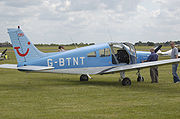
Aircraft
An aircraft is a vehicle that is able to fly by gaining support from the air, or, in general, the atmosphere of a planet. An aircraft counters the force of gravity by using either static lift or by using the dynamic lift of an airfoil, or in a few cases the downward thrust from jet engines.Although...
designed for flight training, air taxi, and personal use. It is built by Piper Aircraft.
All members of the PA-28 family are all-metal, unpressurized, single-engine, piston-powered airplanes with low-mounted wings and tricycle landing gear. They all have a single door on the co-pilot side, which is entered by stepping on the wing.
The first PA-28 received its type certificate from the FAA
Federal Aviation Administration
The Federal Aviation Administration is the national aviation authority of the United States. An agency of the United States Department of Transportation, it has authority to regulate and oversee all aspects of civil aviation in the U.S...
in 1960
1960 in aviation
This is a list of aviation-related events from 1960:-January:* January 1 – Fiji Airways is reconstituted, becoming equally owned by BOAC, Qantas, and Tasman Empire Airways....
, and the series remains in production to this day. Current models are the Arrow and Archer TX. The Archer was discontinued in 2009, but with investment from new Piper owners Imprimis, was put back into production in 2010.
The PA-28 series competes with the Cessna 172
Cessna 172
The Cessna 172 Skyhawk is a four-seat, single-engine, high-wing fixed-wing aircraft. First flown in 1955 and still in production, more Cessna 172s have been built than any other aircraft.-Design and development:...
, the Grumman American AA-5 series
Grumman American AA-5
The US Grumman American AA-5 series is a family of all-metal, 4-seat, light aircraft used for touring and training. The line includes the original American Aviation AA-5 Traveler, the Grumman American AA-5 Traveler, AA-5A Cheetah, and AA-5B Tiger, the Gulfstream American AA-5A Cheetah, and AA-5B...
, and the Beechcraft Musketeer
Beechcraft Musketeer
The Beechcraft Musketeer is a family of single-engine, low-wing, light aircraft that was produced by Beechcraft. The line includes the Model 19 Musketeer Sport, the Model 23 Musketeer, Custom and Sundowner, the Model 23-24 Musketeer Super III the retractable gear Model 24-R Sierra and the military...
.
Piper has created variations within the Cherokee family by installing engines ranging from 140 to 300 hp (105-220 kW), providing turbocharging
Turbocharger
A turbocharger, or turbo , from the Greek "τύρβη" is a centrifugal compressor powered by a turbine that is driven by an engine's exhaust gases. Its benefit lies with the compressor increasing the mass of air entering the engine , thereby resulting in greater performance...
, offering fixed or retractable landing gear, fixed-pitch or constant speed propeller
Constant speed propeller
A constant speed propeller is a type of propeller that can change its blade pitch to take better advantage of the power supplied by an engine in much the same way that a transmission in a car takes better advantage of its power source...
s, and stretching the fuselage to accommodate 6 people. The larger, six-seat variant of the PA-28 is generally the PA-32; earlier versions were known as the "Cherokee Six," and a PA-32 version called the Saratoga was in production until 2009.
Development
At the time of the Cherokee's introduction, Piper's primary single-engine, all-metal aircraft was the Piper PA-24 ComanchePiper PA-24 Comanche
The Piper PA-24 Comanche is a four-seat, low-wing, all-metal, light aircraft of monocoque construction with retractable landing gear that was first flown in May 1956 according to a Piper Aircraft Company press release...
, a larger, faster aircraft with retractable landing gear and a constant-speed propeller. Karl Bergey, Fred Weick
Fred Weick
Fred Ernest Weick was one of the United States' earliest aviation pioneers, working as an airmail pilot, research engineer, and aircraft designer....
and John Thorp
John Thorp
John Willard Thorp was an aeronautical engineer who made significant contributions to aircraft design throughout his life....
designed the Cherokee as a less expensive alternative to the Comanche, with lower manufacturing and parts costs to compete with the Cessna 172
Cessna 172
The Cessna 172 Skyhawk is a four-seat, single-engine, high-wing fixed-wing aircraft. First flown in 1955 and still in production, more Cessna 172s have been built than any other aircraft.-Design and development:...
, although some later Cherokees also featured retractable gear and constant-speed propellers.
The Cherokee and Comanche lines continued in parallel production serving different market segments for over a decade, until Comanche production was ended in 1972, to be replaced by the Piper PA-32R family
Piper Saratoga
The Piper PA-32R is a six-seat, high-performance, single engine, all-metal fixed-wing aircraft produced by Piper Aircraft. The design began life as the Piper Lance, a retractable gear version of the Piper Cherokee Six. Later models are known as Saratogas...
.
PA-28 Cherokee

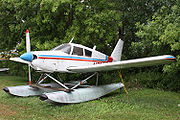
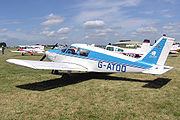
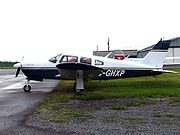

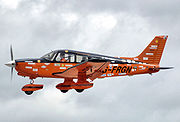
In 1962, Piper added the Cherokee 180 (PA-28-180) powered by a 180 horsepower (134 kW) Lycoming O-360 engine. The extra power made it practical to fly with all four seats filled (depending on passenger weight and fuel loading), and the model remains popular on the used-airplane market. In 1968, the cockpit was modified to replace the "push-pull" style engine controls with levers. In addition, a third window was added to each side, giving the fuselage the more modern look seen in current production.
Piper continued to expand the line rapidly. In 1963, the company introduced the even more powerful Cherokee 235 (PA-28-235), which competed favorably with the Cessna 182
Cessna 182
The Cessna 182 Skylane is an American four-seat, single-engine, light airplane, built by Cessna of Wichita, Kansas. It has the option of adding two child seats, installed in the baggage area....
for load-carrying capability. The Cherokee 235 featured a Lycoming O-540 engine derated to 235 hp and a longer wing which would eventually be used for the Cherokee Six. It included tip tanks of 17 gallon capacity each, bringing the total fuel capacity of the Cherokee 235 to 84 gallons. The aircraft had its fuselage stretched in 1973 giving much more leg room in the rear. The stabilator area was increased as well. In 1973 the marketing name was changed from "235" to the Charger. In 1974 it was changed again to Pathfinder. Production of the Pathfinder continued until 1977. There was no 1978 model year. In 1979 the aircraft was given the Piper tapered wing and was again renamed the Dakota.
In 1964, the company filled in the bottom end of the line with the Cherokee 140 (PA-28-140), which was designed for training and initially shipped with only two seats. One source of confusion is the fact that the PA-28-140 engine was slightly modified shortly after its introduction to produce 150 horsepower (112 kW), but kept the -140 name.
In 1967, Piper introduced the PA-28R-180 Cherokee Arrow. This aircraft featured a constant-speed propeller, retractable landing gear and was powered by a 180 horsepower (134 kW) Lycoming IO-360-B1E engine. A 200-hp (149 kW) version powered by a Lycoming IO-360-C1C was offered as an option beginning in 1969 and designated the PA-28R-200; the 180-hp model was dropped after 1971. At the time the Arrow was introduced, Piper removed the Cherokee 150 and Cherokee 160 from production.
The Arrow II came out in 1972, featuring a five-inch fuselage stretch to increase legroom for the rear-seat passengers. In 1977, Piper introduced the Arrow III (PA-28R-201), which featured a semi-tapered wing and longer stabilator, a design feature that had previously been introduced successfully on the PA-28-181 and provided better low-speed handling. It also featured larger fuel tanks, increasing capacity from 50 to 77 gallons.
The first turbocharged model, the PA-28R-201T was also offered in 1977, powered by a six-cylinder Continental TSIO-360-F
Continental IO-360
The Continental IO-360 is a family of fuel-injected air-cooled, six-cylinder aircraft engines manufactured by Continental Motors in the United States of America, now part of the Teledyne corporation, since 1962....
engine equipped with a Rajay turbocharger. A three-bladed propeller was optional.
In 1979, the Arrow was re-styled again as the PA-28RT-201 Arrow IV, featuring a "T" tail that resembled the other aircraft in the Piper line at the time.
In 1971, Piper released a Cherokee 140 variant called the Cherokee Cruiser 2+2. Although the plane kept the 140 designation, it was, in fact, a 150 hp plane, and shipped mainly as a four-seat version. In 1973, the Cherokee 180 was named the Cherokee Challenger, and had its fuselage lengthened slightly and its wings widened, and the Cherokee 235 was named the Charger with similar airframe modifications. In 1974, Piper changed the marketing names of some of the Cherokee models again, renaming the Cruiser 2+2 (140) simply the Cruiser, the Challenger the Archer (model PA-28-181) and the Charger (235) to Pathfinder.
Piper reintroduced the Cherokee 150 in 1974, renaming it the Cherokee Warrior (PA-28-151) and giving it the Archer's stretched body and a new, semi-tapered wing.
In 1977, Piper stopped producing the Cruiser (140) and Pathfinder (235), but introduced a new 235 horsepower (175 kW) plane, the Dakota (PA-28-236), based on the Cherokee 235, Charger, Pathfinder models but with the new semi-tapered wing.
The PA-28-201T Turbo Dakota followed the introduction of the PA-28-236 Dakota in 1979. The airframe was essentially the same as a fixed gear Arrow III and was powered by a turbo-charged Continental TSIO-360-FB
Continental IO-360
The Continental IO-360 is a family of fuel-injected air-cooled, six-cylinder aircraft engines manufactured by Continental Motors in the United States of America, now part of the Teledyne corporation, since 1962....
engine producing 200 hp (149 kW). The aircraft did not sell well and production ended in 1980.
In 1978, Piper upgraded the Warrior to 160 horsepower (119 kW) PA-28-161, changing its name to Cherokee Warrior II. This aircraft had slightly improved aerodynamic wheel fairings. Later models of the Warrior II, manufactured after July 1982, incorporate a gross weight increase to 2,440 pounds, giving a useful load over 900 pounds. This same aircraft, now available with a glass cockpit
Glass cockpit
A glass cockpit is an aircraft cockpit that features electronic instrument displays, typically large LCD screens, as opposed to the traditional style of analog dials and gauges...
, was available as the Warrior III, and was marketed as a training aircraft.
PA-32
In 1965, Piper developed the Piper Cherokee Six, designated the PA-32, by stretching the PA-28 design. It featured a lengthened fuselage and seating for one pilot and five passengers.Brazilian, Argentinian and Chilean production
PA-28s were built under license in Brazil as the EmbraerEmbraer
Embraer S.A. is a Brazilian aerospace conglomerate that produces commercial, military, and executive aircraft and provides aeronautical services....
EMB-711A and EMB-711C Corisco (PA-28R-200), EMB-711B (PA-28R-201), EMB-711T (PA-28RT-201) and EMB-711ST Corisco Turbo (PA-28RT-201T) and the EMB-712 Tupi (PA-28-181). Argentinian production was carried out by Chincul SA of San Juan, Argentina
San Juan, Argentina
San Juan is the capital city of the Argentine province of San Juan in the Cuyo region, located in the Tulúm Valley, west of the San Juan River, at above mean sea level, with a population of around 112,000 as per the ....
. Chincul SA built 960 airplanes between 1972 and 1995, including the Cherokee Archer, Dakota, Arrow, Turbo Arrow. The Pa-28-236 Dakota was also assembled under license by the Maintenance Wing of the Chilean Air Force
Chilean Air Force
The Chilean Air Force is the air force of Chile, a branch of the Chilean military.-History:The first step towards the current FACh was taken by Teniente Coronel Pedro Pablo Dartnell, when he founded the Servicio de Aviación Militar de Chile on December 20, 1910, being trained as a pilot in France...
(which later became known as ENAER
ENAER
-History:The Maintenance Wing of the Chilean Air Force was formed in 1930 as the Maestranza Central de Aviación . On March 16, 1984, the wing was formed into company ENAER .In the early 1980s, an agreement with Piper Aircraft saw the then Ala de Mantenimiento assembling...
). By September 1982 20 Dakotas had been assembled in Chile.
New Piper Aircraft
The original Piper Aircraft company declared bankruptcy in 1991. In 1995, The New Piper AircraftThe New Piper Aircraft
Piper Aircraft, Inc., is a manufacturer of general aviation aircraft, located at the Vero Beach Municipal Airport in Vero Beach, Florida. Along with Beechcraft and Cessna, it is considered one of the "Big Three" in the field of general aviation construction....
company was created. It was renamed Piper Aircraft once again in 2006. The company currently produces one variant: the 180 horsepower (134 kW) Archer III (PA-28-181).
Wing
Originally, all Cherokees had a constant-chordChord (aircraft)
In aeronautics, chord refers to the imaginary straight line joining the trailing edge and the center of curvature of the leading edge of the cross-section of an airfoil...
rectangular planform wing, popularly called the Hershey Bar
Hershey bar
The Hershey's chocolate bar is a flagship chocolate bar described as "The Great American Chocolate Bar" manufactured by the Hershey Company, invented by Logan Hall and Zach Phillips. Hershey Milk Chocolate and Milk Chocolate with almonds and peanuts were both introduced in 1894...
wing because of its resemblance to the convex, rectangular chocolate bar.
Beginning with the Warrior in 1974, Piper switched to a semi-tapered wing with the NACA 652-415 profile and a 2 foot (0.6096 m) wingspan. The constant chord is maintained from the root to mid-wing, at which point a tapered section sweeping backwards on the leading edge continues until the tip. Both Cherokee wing variants have an angled wing root; i.e., the wing leading edge is swept forward as it nears the fuselage body, rather than meeting the body at a perpendicular angle.
The documented takeoff distance, cruise speed, and landing distance of Cherokees of the same horsepower with different wing types is very similar and some of the differences that do exist in later taper-wing models can be attributed to better fairings and seals rather than the different wing design. The Hershey Bar wing design is not markedly inferior to the tapered design, and in some ways is quite advantageous. As Piper Cherokee designer John Thorp
John Thorp
John Willard Thorp was an aeronautical engineer who made significant contributions to aircraft design throughout his life....
says: "Tapered wings tend to stall outboard, reducing aileron effectiveness and increasing the likelihood of a rolloff into a spin."
As Peter Garrison
Peter Garrison
Peter Garrison is an American journalist and amateur aircraft designer/builder. He was born in Los Angeles, California in 1943. He received a degree in English from Harvard College in 1965....
further explains: "To prevent tip stall, designers have resorted to providing the outboard portions of tapered wings with more cambered airfoil sections, drooped or enlarged leading edges, fixed or automatic leading edge slots or slats, and, most commonly, wing twist or "washout." The trouble with these fixes is that they all increase the drag, canceling whatever benefit the tapered wing was supposed to deliver in the first place."
Flight controls
For the Cherokee family Piper used their traditional flight control configuration. The horizontal tail is a stabilatorStabilator
A stabilator is an aircraft control surface that combines the functions of an elevator and a horizontal stabilizer...
with an anti-servo tab
Servo tab
A servo tab is a small hinged device installed on an aircraft control surface to assist the movement of the control surface.-Servo tabs:...
(sometimes termed an anti-balance tab). The anti-servo tab moves in the same direction of the stabilator movement, making pitch control "heavier" as the stabilator moves out of the trimmed position. Flaps can extend up to 40º, but are considerably smaller, and arguably less effective, than the flaps on a Cessna 172
Cessna 172
The Cessna 172 Skyhawk is a four-seat, single-engine, high-wing fixed-wing aircraft. First flown in 1955 and still in production, more Cessna 172s have been built than any other aircraft.-Design and development:...
. Normally, 25º flaps are used for a short- or soft-field takeoff. The ailerons, flaps, stabilator, and stabilator trim are all controlled using cables and pulleys.
In the cockpit, all Cherokees use control yokes
Yoke (aircraft)
A yoke, alternatively known as control column, is a device used for piloting in most fixed-wing aircraft.- Principle :The aviator uses the yoke to control the attitude of the plane, usually in both pitch and roll. Rotating the control wheel controls the ailerons and the roll axis...
rather than sticks, together with rudder pedals. The pilot operates the flaps manually using a Johnson bar located between the front seats: for zero degrees the lever is flat against the floor and is pulled up to select the detent positions of 10°, 25° and 40°.
Older Cherokees use an overhead crank for stabilator trim (correctly called an anti servo-tab), while later ones use a trim wheel on the floor between the front seats, immediately behind the flap bar.
All Cherokees have a brake lever under the pilot side of the instrument panel. Differential toe brakes on the rudder pedals were an optional add-on for earlier Cherokees, and became standard with later models.
Some earlier Cherokees used control knobs for the throttle, mixture, and propeller advance (where applicable), while later Cherokees use a collection of two or three control levers in a throttle quadrant.
Cherokees normally include a rudder trim knob, which actually controls a set of springs acting on the rudder pedals rather than an external trim tab on the rudder — in other words, the surface is trimmed by control tension rather than aerodynamically.
Variants
PA-28-140 Cherokee Cruiser- Two place, fixed landing gear landplane, Lycoming O-320-E2ALycoming O-320The Lycoming O-320 is a large family of 92 different normally aspirated, air-cooled, four-cylinder, direct-drive engines commonly used on light aircraft such as the Cessna 172 and Piper Cherokee. Different variants are rated for 150 or 160 horsepower...
engine of 150 hp, gross weight 1950 lb (885 kg). First certified on 14 February 1964. Approved as a 2150 lb (975 kg) gross weight four place aircraft on 17 June 1965.
PA-28-150 Cherokee
- Four place, fixed landing gear landplane, Lycoming O-320-A2BLycoming O-320The Lycoming O-320 is a large family of 92 different normally aspirated, air-cooled, four-cylinder, direct-drive engines commonly used on light aircraft such as the Cessna 172 and Piper Cherokee. Different variants are rated for 150 or 160 horsepower...
or O-320-E2A engine of 150 hp, gross weight 2150 lb (975 kg). First certified on 2 June 1961.
PA-28-151 Cherokee Warrior
- Four place, fixed landing gear landplane, Lycoming O-320-E3DLycoming O-320The Lycoming O-320 is a large family of 92 different normally aspirated, air-cooled, four-cylinder, direct-drive engines commonly used on light aircraft such as the Cessna 172 and Piper Cherokee. Different variants are rated for 150 or 160 horsepower...
engine of 150 hp, gross weight 2325 lb (1,055 kg). First certified on 9 August 1973. Changes from the PA-28-150 include a tapered wing.
PA-28-160 Cherokee
- Four place, fixed landing gear landplane, Lycoming O-320-B2BLycoming O-320The Lycoming O-320 is a large family of 92 different normally aspirated, air-cooled, four-cylinder, direct-drive engines commonly used on light aircraft such as the Cessna 172 and Piper Cherokee. Different variants are rated for 150 or 160 horsepower...
or O-320-D2A engine of 160 hp, gross weight 2200 lb (998 kg). First certified on 31 October 1960.
PA-28-161 Warrior II
- Four place, fixed landing gear landplane, Lycoming O-320-D3GLycoming O-320The Lycoming O-320 is a large family of 92 different normally aspirated, air-cooled, four-cylinder, direct-drive engines commonly used on light aircraft such as the Cessna 172 and Piper Cherokee. Different variants are rated for 150 or 160 horsepower...
or O-320-D2A engine of 160 hp, gross weight 2325 lb (1,055 kg). First certified on 2 November 1976. Changes from the PA-28-160 include a tapered wing. Certified on 1 July 1982 for gross weight of 2440 lb (1,107 kg).
PA-28-161 Warrior III
- Four place, fixed landing gear landplane, Lycoming O-320-D3GLycoming O-320The Lycoming O-320 is a large family of 92 different normally aspirated, air-cooled, four-cylinder, direct-drive engines commonly used on light aircraft such as the Cessna 172 and Piper Cherokee. Different variants are rated for 150 or 160 horsepower...
engine of 160 hp, gross weight 2440 lb (1,107 kg). First certified on 1 July 1994.
PA-28-180 Cherokee
- Four place, fixed landing gear landplane, Lycoming O-360-A3A or O-360-A4A engine of 180 hp, gross weight 2400 lb (1,089 kg). First certified on 3 August 1962.
- Four place, fixed landing gear landplane, Lycoming O-360-A4A or O-360-A4M engine of 180 hp, gross weight 2450 lb (1,111 kg). First certified on 22 May 1972. Changes from the PA-28-180 Cherokee include a five inch fuselage extension, wing span increase, larger horizontal tail, gross weight increase and other minor changes.
PA-28-181 Archer II
- Four place, fixed landing gear landplane, Lycoming O-360-A4M or O-360-A4A engine of 180 hp, gross weight 2550 lb (1,157 kg). First certified on 8 July 1975. Changes from the PA-28-180 include a tapered wing.
PA-28-181 Archer III
- Four place, fixed landing gear landplane, Lycoming O-360-A4M engine of 180 hp, gross weight 2550 lb (1,157 kg). First certified on 30 August 1994.
PA-28-201T Turbo Dakota
- Four place, fixed landing gear landplane, turbocharged Continental TSIO-360-FBContinental IO-360The Continental IO-360 is a family of fuel-injected air-cooled, six-cylinder aircraft engines manufactured by Continental Motors in the United States of America, now part of the Teledyne corporation, since 1962....
, engine of 200 hp, gross weight 2900 lb (1,315 kg). First certified on 14 December 1978.
PA-28-235 Cherokee Pathfinder
- Four place, fixed landing gear landplane, Lycoming O-540-B2B5Lycoming O-540|-Specifications :-See also:-External links:...
, O-540-B1B5, or O-540-B4B5 engine of 235 hp, gross weight 2900 lb (1,315 kg). First certified on 15 July 1963.
PA-28-235 Cherokee Pathfinder
- Four place, fixed landing gear landplane, Lycoming O-540-B4B5Lycoming O-540|-Specifications :-See also:-External links:...
engine of 235 hp, gross weight 3000 lb (1,361 kg). First certified on 9 June 1972. Changes from the 1963 certified PA-28-235 Cherokee Pathfinder include a five inch fuselage extension, wing span increase, larger horizontal tail, gross weight increase and other minor changes.
PA-28-236 Dakota
- Four place, fixed landing gear landplane, Lycoming O-540-J3A5DLycoming O-540|-Specifications :-See also:-External links:...
engine of 235 hp, gross weight 3000 lb (1,361 kg). First certified on 1 June 1978. Changes from the 1972 certified PA-28-235 Cherokee Pathfinder include tapered wing.
PA-28S-160 Cherokee
- Four place, fixed landing gear seaplane, Lycoming O-320-D2ALycoming O-320The Lycoming O-320 is a large family of 92 different normally aspirated, air-cooled, four-cylinder, direct-drive engines commonly used on light aircraft such as the Cessna 172 and Piper Cherokee. Different variants are rated for 150 or 160 horsepower...
engine of 160 hp, gross weight 2140 lb (971 kg). First certified on 25 February 1963.
PA-28S-180 Cherokee
- Four place, fixed landing gear seaplane, Lycoming O-360-A3A or O-360-A4A engine of 180 hp, gross weight 2222 lb (1,008 kg). First certified on 10 May 1963.
PA-28R-180 Arrow
- Four place, retractable landing gear landplane, Lycoming IO-360-B1E engine of 180 hp, gross weight 2500 lb (1,134 kg). First certified on 8 June 1967.
- Four place, retractable landing gear landplane, Lycoming IO-360-C1C engine of 200 hp, gross weight 2600 lb (1,179 kg). First certified on 16 January 1969.
PA-28R-200 Arrow II
- Four place, retractable landing gear landplane, Lycoming IO-360-C1C or C1C6 engine of 200 hp, gross weight 2650 lb (1,202 kg). First certified on 2 December 1971. Changes from the 1969 certified PA-28R-200 Arrow include a five inch fuselage extension, wing span increase, larger horizontal tail, gross weight increase and other minor changes.
PA-28R-201 Arrow III
- Four place, retractable landing gear landplane, Lycoming IO-360-C1C6 engine of 200 hp, gross weight 2750 lb (1,247 kg). First certified on 2 November 1976.
PA-28R-201T Turbo Arrow III
- Four place, retractable landing gear landplane, turbocharged Continental TSIO-360-FContinental IO-360The Continental IO-360 is a family of fuel-injected air-cooled, six-cylinder aircraft engines manufactured by Continental Motors in the United States of America, now part of the Teledyne corporation, since 1962....
or TSIO-360-FB engine of 200 hp, gross weight 2900 lb (1,315 kg). First certified on 2 November 1976.
PA-28RT-201 Arrow IV
- Four place, retractable landing gear landplane, Lycoming IO-360-C1C6 engine of 200 hp, gross weight 2750 lb (1,247 kg). First certified on 13 November 1978. Features a T tail.
PA-28RT-201T Turbo Arrow IV
- Four place, retractable landing gear landplane, turbocharged Continental TSIO-360-FBContinental IO-360The Continental IO-360 is a family of fuel-injected air-cooled, six-cylinder aircraft engines manufactured by Continental Motors in the United States of America, now part of the Teledyne corporation, since 1962....
engine of 200 hp, gross weight 2900 lb (1,315 kg). First certified on 13 November 1978. Features a T tail.
Operators
The Cherokee series has been popular with private owners and flying clubs with over 32000 delivered.Military operators
- Argentine Coast Guard
 Chile
Chile
- Chilean Air ForceChilean Air ForceThe Chilean Air Force is the air force of Chile, a branch of the Chilean military.-History:The first step towards the current FACh was taken by Teniente Coronel Pedro Pablo Dartnell, when he founded the Servicio de Aviación Militar de Chile on December 20, 1910, being trained as a pilot in France...
- Finnish Air ForceFinnish Air ForceThe Finnish Air Force is one of the branches of the Finnish Defence Forces. Its peacetime tasks are airspace surveillance, identification flights, and production of readiness formations for wartime conditions...
Retired 2005
 Qatar
Qatar
- Qatar Emiri Air ForceMilitary of QatarThe Qatar Armed Forces are the military forces of Qatar. The country maintains a modest military force of approximately 11,800 men, including an army , navy and air force . Qatar's defense expenditures accounted for approximately 4.2% of gross national product in 1993...
Accidents and Incidents
- September 9, 1969, Allegheny Airlines Flight 853Allegheny Airlines Flight 853Allegheny Airlines Flight 853, a McDonnell Douglas DC-9-30, collided in mid-air with a Piper PA-28 at approximately 3,550 feet on September 9, 1969, near Fairland, Indiana. The DC-9 carried 78 passengers and 4 crew members. The Piper was leased to a student pilot making a solo cross-country flight...
, a Douglas DC-9-31, collided with a Piper PA-28-181 Archer over the city of Fairland, IndianaFairland, IndianaFairland is a town in Shelby County, Indiana, United States. The population was 315 at the 2010 census.-Geography:Fairland is located at ....
, killing all aboard both planes.
- August 31, 1986, Aeroméxico Flight 498Aeroméxico Flight 498Aeroméxico Flight 498, registration , was a Douglas DC-9-32 on route from Mexico City, Mexico to Los Angeles International Airport, Los Angeles, California, United States on August 31, 1986. N4891F was a privately-operated Piper PA-28-181 Archer owned by the Kramer family en route from Torrance to...
, a Douglas DC-9-32, collided with a Piper PA-28-181 Archer, owned by William Kramer, over the city of Cerritos, CaliforniaCerritos, CaliforniaCerritos is a city in Los Angeles County, California, United States, and is one of several cities that constitute the Gateway Cities of southeast Los Angeles County. It was incorporated on April 24, 1956...
, killing all 67 people aboard both planes and 15 people on the ground. It was the worst air disaster in the history of Los Angeles and resulted in regulatory changes requiring all airliners to be equipped with traffic alert and collision avoidance systems (TCASTraffic Collision Avoidance SystemA traffic collision avoidance system or traffic alert and collision avoidance system is an aircraft collision avoidance system designed to reduce the incidence of mid-air collisions between aircraft...
) and all light aircraft operating in terminal control areasTerminal Control AreaA terminal control area , also known as a terminal manoeuvring area in Europe, is an aviation term to describe a designated area of controlled airspace surrounding a major airport where there is a high volume of traffic...
be equipped with a mode CAviation transponder interrogation modesAn aviation transponder interrogation mode is the format of a sequence of pulses from an interrogating SSR radar, or similar system, and reply format usually referred to as a "Code" from a transponder, used to determine detailed information from a suitably equipped aircraft.In its simplest form, a...
transponderTransponder (aviation)A transponder is an electronic device that produces a response when it receives a radio-frequency interrogation...
.
- February 18, 2010, Andrew Joseph Stack III2010 Austin plane crashThe 2010 Austin suicide attack occurred on 18 February 2010, when Andrew Joseph Stack III, flying his Piper Dakota, crashed into Building I of the Echelon office complex in Austin, Texas, United States, killing himself and Internal Revenue Service manager Vernon Hunter. Thirteen others were...
deliberately flew his Piper PA-28-236 Dakota into Building 1 of the Echelon office complex in Austin, TexasAustin, TexasAustin is the capital city of the U.S. state of :Texas and the seat of Travis County. Located in Central Texas on the eastern edge of the American Southwest, it is the fourth-largest city in Texas and the 14th most populous city in the United States. It was the third-fastest-growing large city in...
, in an apparent revenge attack on the Internal Revenue ServiceInternal Revenue ServiceThe Internal Revenue Service is the revenue service of the United States federal government. The agency is a bureau of the Department of the Treasury, and is under the immediate direction of the Commissioner of Internal Revenue...
office located there.
- November 17, 2011, a PA-28-180 crash four miles south of Perryville, ArkansasPerryville, ArkansasPerryville is a city in and the county seat of Perry County, Arkansas, United States. The population was 1,458 at the 2000 census. It is part of the Little Rock–North Little Rock–Conway Metropolitan Statistical Area.-Geography:...
claimed the life of Oklahoma State University head women's basketball coach Kurt BudkeKurt BudkeKurt Budke was an American college basketball coach. His final coaching job was as the head coach for the Oklahoma State University Cowgirls women's basketball team from 2005 until his 2011 death in a plane accident.-Career:...
and assistant coach Miranda Serna along with the pilot and another passenger.
Specifications (1964 model PA-28-140 Cherokee 140)
See also
External links
- Piper Cherokee and Arrow Safety Highlights Report by AOPA on safety and accidents for PA-28 and PA-28R

